Horsted Place
Horsted Place is a Tudor Revival country house, now a hotel, in Little Horsted, East Sussex, England. The current building dates to 1850,[1] when it was built by Samuel Dawkes/George Myers for Francis Barchard,[2] a successful merchant from London, though an earlier house evidently existed as it was documented as being owned by the Law family in 1816.[3] It is described as "A masterpiece of ornate Victorian Gothic, it has towers, tall brick chimneys and a great central Gallery running through its entire length."[1]
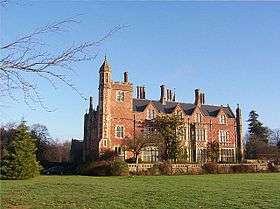
Horsted Place is listed Grade II on the National Heritage List, and its gardens are also listed Grade II on the Register of Historic Parks and Gardens.[4][5]
Barchard family
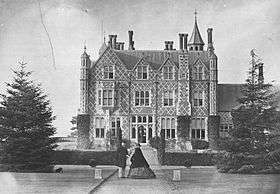
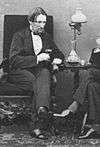
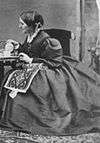
Francis Barchard (1796-1856) built Horsted Place in about 1850. A photo of the house is shown soon after it was constructed. Francis was born in 1796 in Little Bookham, Surrey. His father was Joseph Barchard who was a farmer and his mother was Jane Royle. He also became a farmer and bought a property called Ashcombe at Lewes.[6] The property still exists and is owned by the University of Sussex.[7] In 1824 he married Margaret Jane Piggott[8] who was the daughter of Elphinstone Piggott, the Chief Justice of Tobago. The couple had four children, three sons and a daughter. Unfortunately in 1829 Margaret his wife died leaving Francis to raise four infants.
Francis's relatives had developed a successful dying business at Wandsworth and his sister-in-law's brother Francis Hilton who was a partner in this business left him a large fortune. Francis Hilton was his godfather and as he was unmarried and had no heirs he left him almost his whole estate when he died in 1845.[9] Soon after Francis Barchard began to build Horsted Place.
In 1856 Francis died and his eldest son also called Francis Barchard (1826–1904) inherited Horsted Place. Francis was born in 1826 in London. He was educated at Oxford University and became a barrister. In 1861 he married Arentina Watson daughter of John Watson of Wick Lodge in Brighton.[10] A photo of each is shown and they are also shown together in the photo of Horstead Place in 1860. The couple had no children and spent a great deal of time in Brighton.
Francis died in 1904 and as he had no heirs the property was inherited by his nephew who was also called Francis Barchard (1863–1932). Francis was born in 1863 in Brighton.[11] His father was Elphinstone Barchard and his mother was Katherine Louisa Barwell. He was educated at Oxford and became a barrister. In 1901 he married Maud Agnes Robertson.[12]
The couple had two children a son and a daughter. Unfortunately his son was killed in action in the War in 1941.[13] After Francis died in 1932 his wife Maud lived at Horsted Place until her death in 1964. In the following year the property was sold to Lord Rupert Nevill.
Lord and Lady Rupert Nevill
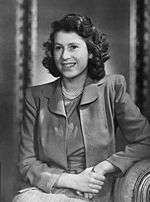
Lady Rupert Nevill was a personal childhood friend of Queen Elizabeth II. She was born Lady Anne Camilla Wallop (nickname Micky) and her father was The 9th Earl of Portsmouth.[14] She was in the same Girl Guide Group as Princess Elizabeth and they had become lifelong friends.[15] In 1944 she married Lord Rupert Nevill, who was the second son of Major The 4th Marquess of Abergavenny.
The couple lived at Uckfield House (now demolished) which was not far from Little Horsted. During that time they had numerous visits from the Royal Family. They had four children, two sons and two daughters. Queen Elizabeth became the godmother for the first time for their infant son in 1945.[16]
In 1965 they bought Horsted Place and Queen Elizabeth and Prince Philip continued to visit them there. In 1970 he became the Treasurer for Prince Philip then in 1975 he became his Private Secretary.[17] In 1982 Lord Rupert Nevill died and soon after Horsted Place was converted to a hotel. It still serves this function.
References
- Arnold, Wendy; Morrison, Robin (April 1989). The historic country hotels of England: a select guide. Chronicle Books. p. 93. ISBN 978-0-87701-627-4.
- Pugin, Augustus Welby Northmore; Atterbury, Paul (1995). A.W.N. Pugin: Master of Gothic Revival. Bard Graduate Center for Studies in the Decorative Arts, New York. p. 197. ISBN 978-0-300-06656-2.
- The Asiatic Journal and Monthly Register for British India and Its Dependencies. Black, Parbury, & Allen. 1816. p. 619.
- Historic England, "Horsted Place (1353586)", National Heritage List for England, retrieved 2 December 2016
- Historic England, "Horsted Place (1000202)", National Heritage List for England, retrieved 2 December 2016
- The Farmers Magazine, Vol 7. Online reference
- British Listed Buildings. Online reference
- Marriage Record 1824. Online reference https://familysearch.org/ark:/61903/1:1:NJWC-YZH
- Online reference
- The County Families of the United Kingdom. Online reference
- Birth Certificate extract. Online reference
- Winchester College 1836-1906. Online reference
- The Peerage website. Online reference http://www.thepeerage.com/p5010.htm#i50097
- The Peerage website http://www.thepeerage.com/p1442.htm#i14412
- Pimlott, Ben 1998 “The Queen: A Biography of Elizabeth”, p. 49. Online reference
- The Age , 26 June 1945, p. 2. Online reference
- "Lord Rupert Nevill." Times [London, England] 20 July 1982: 12. The Times Digital Archive. Web. 11 Jan. 2016.